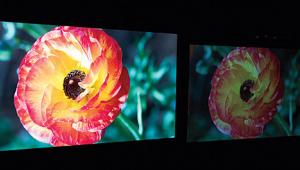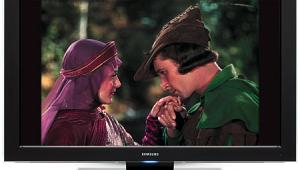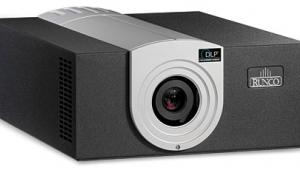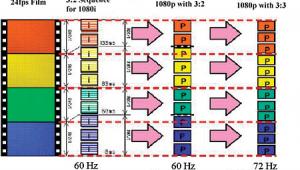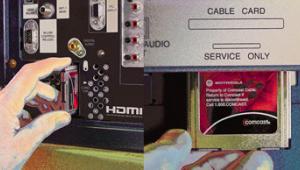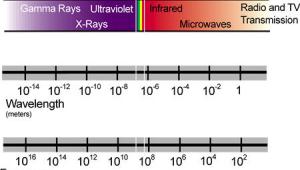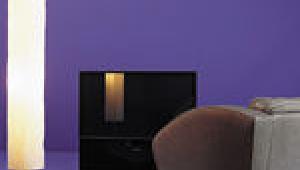HD Unplugged
Imagine being able to place that brand-new flat-panel HDTV anywhere in your living room without having to figure out how to hide the video cable that tethers it to your A/V receiver, DVD player, or set-top box. You won't have to imagine it much longer as wireless HD transmission moves from the drawing board to the retail shelves. As always seems to be the case in this industry, we'll go from having virtually no options to having multiple technologies competing for the attention of manufacturers and consumers alike.
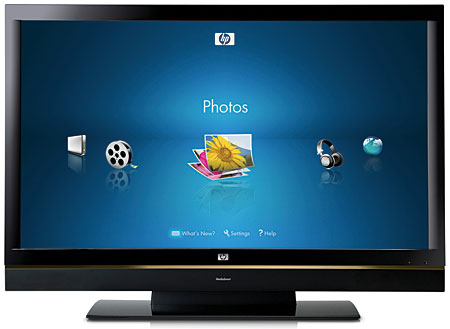
HP MediaSmart TV
The first challenge for any wireless-HD technology is data rate, or the speed of data transfer. Many people incorrectly refer to this as "bandwidth," which is related but different. (See the sidebar on page 37.) It takes approximately 1.3 gigabits per second to transfer uncompressed 720p, 1.5 Gbps for uncompressed 1080i, and 3 Gbps for uncompressed 1080p. The first question a developer must ask when designing a method of wireless video transmission is, to compress or not to compress? The same questions that once inspired the HDMI-versus-FireWire debate are now going on in the wireless realm, and proponents in both camps will passionately defend their chosen methods.
Data rate isn't the only concern. High-definition video isn't very forgiving, and neither are its viewers; they demand quality, reliability, and flexibility. As we look at each wireless technology, we'll touch on some important differences: how they handle the data, what frequency bands they function in, and what kind of transmission ranges they offer. Keep in mind that the companies involved have supplied the information below; as actual products become available, we will put their claims to the test.
802.11n
The convergence-minded HD fan who wishes to wirelessly stream compressed HD video from a computer to a TV will hail the arrival of the newest, and fastest, Wi-Fi format: 802.11n. The current formats offer a theoretical maximum transfer rate of 54 megabits per second, but actual throughput is usually much less than what's needed to reliably and consistently stream high definition, even in a compressed form. Also, the popular 802.11g standard operates in the crowded, interference-prone 2.4-gigahertz frequency range, where it competes with microwave ovens, cordless telephones, Bluetooth, and more.
The new 802.11n spec can operate at either 2.4 or 5 GHz and is capable of up to 540 Mbps. Actual throughput and range vary based on distance and other environmental factors, but quoted numbers hover around 100 Mbps at a distance of 300 feet. To help increase throughput and range, 802.11n employs a smart-antenna technology called MIMO (multiple-input multiple-output) in which multiple antennas are used to both transmit and receive.
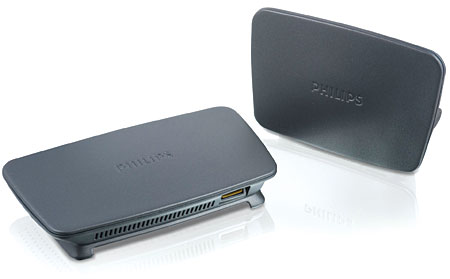
Philips SWW1800
The official 802.11n spec is not expected to be finalized until fall 2008, but many companies have already released 802.11n products. Such "Pre-N" or "Draft N" devices offer the basic features, but interoperability between manufacturers isn't a given, and firmware updates will likely be necessary. When choosing a router, consider a dual-band model, such as Apple's AirPort Extreme, D-Link's DIR-855, or Buffalo's AirStation Nfiniti, which work in both the 2.4- and 5-GHz bands. The Apple TV digital media receiver ($299) communicates with a Mac or PC over 802.11n, and HP's second-generation MediaSmart TVs (due in mid-summer) use 802.11n for their built-in digital media receivers, so you can stream HD video directly to the TV.
Ultra-Wideband (UWB)
If you're looking for a straightforward HDMI cable replacement, the first products scheduled to hit the market are based on Ultra-Wideband technology. As its name suggests, UWB is an RF technology that works over a wider frequency range, sending out bursts of information that radiate over many frequencies from 3.1 to 10.6 GHz, so it's less susceptible to interference. Wireless UWB is a highly secure, low-power technology that's best suited to shorter-range communication, around 30 feet. It's capable of speeds up to 480 Mbps and can be used for a variety of applications, including Wireless USB, Bluetooth 3.0, and A/V distribution.
One company focused on UWB as a means of HD video distribution is Tzero Technologies, which has developed a solution for transmitting compressed HD signals both wirelessly for in-room scenarios (directly between a source and TV) and over a home's coaxial cable for multiroom A/V distribution. The wireless implementation has a sustained throughput of around 100 Mbps, supports 1080p, and uses Analog Devices' JPEG2000 compression technology, which Tzero feels does a better job of error handling than MPEG to render a higher-quality picture.
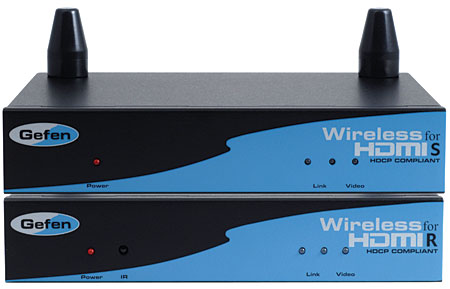
Gefen Wireless for HDMI Extender
This year, Gefen and Terk are scheduled to release products based on Tzero's technology. Each product consists of a transmitter box that connects to your A/V receiver or source(s) and a receiver unit that connects to your TV; the HDMI connections are HDCP-compliant HDMI 1.3. The specs for Gefen's Wireless for HDMI Extender ($699, due this summer) aren't finalized, but it should support 1080p video and multichannel digital audio at up to 30 feet. Terk's HDMI-UWB ($400) also supports 1080p at up to 30 feet and features a transmitter box with HDMI, component, composite, and analog audio inputs to accommodate multiple sources. It's scheduled for release in the fourth quarter.
The next round of Tzero-based products will be integrated TV solutions with embedded receivers and separate transmitter dongles. The company's long-term goal is to embed the technology into a wide range (pardon the pun) of CE and PC devices. Tzero is part of the WiMedia Alliance, so all of these products are expected to play nice with any WiMedia-compliant UWB device.
• www.tzerotech.com
WireFreeHD
Radiospire's WireFreeHD format also uses UWB technology, operating specifically in the 3.1-to-4.8-GHz range. What distinguishes WireFreeHD from other UWB designs is that it can supposedly achieve speeds up to 3 Gbps to transmit uncompressed 1080p from up to 25 feet; unfortunately, I was unable to interview anyone at Radiospire to flesh out the details behind the technology. The first product to utilize WireFreeHD is Philips' SWW1800 wireless HDMI dongle. The company showed off a prototype at CES that consisted of small transmitter and receiver boxes, each with a single HDCP-compliant HDMI 1.3 connection. The technology does not require line of sight and will work through cabinets and walls up to 25 feet. The SWW1800 is scheduled for release in fall 2007 with an estimated price of $300 to $400. On their Website, Radiospire is also showing off their own line of transmitter/receiver products, but no pricing or release dates are offered.
• www.radiospire.com
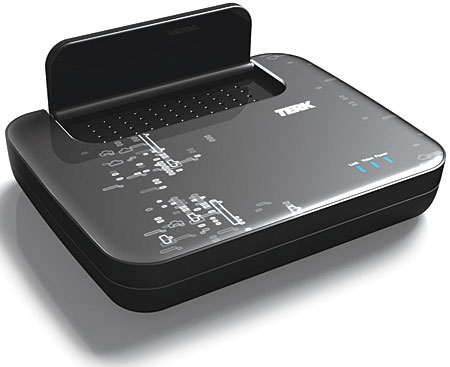
Terk HDMI-UWB
Wireless High Definition Interface (WHDI)
WHDI, developed by an Israel-based semiconductor company called Amimon, claims to allow for the transmission of uncompressed HD signals at a range of over 100 feet. WHDI operates in the 5-GHz frequency band and is capable of up to 1.5 Gbps of video (for uncompressed 1080i or 720p) in a single 20-MHz channel or 3 Gbps of video (for 1080p) in a 40-MHz channel. To achieve this, Amimon combines MIMO technology with a "video modem" approach to the coding process in which the video processors arrange the signal's components according to their importance and apply better encoding to the most significant bits—as compared with "data modem" technologies that treat all bits equally.
Motorola and Pixelworks are two of Amimon's high-profile partners, and the company is currently in licensing talks with a number of manufacturers. They plan to have product on the market by the end of the year, including standalone transmitter/receiver dongles and several wireless HD projectors in which the receiver is embedded in the projector and a separate transmitter box is included. At CES, Sanyo demonstrated a prototype of their wireless PLC-XF47N projector, which had an embedded WHDI chip. The projector displayed a 720p signal, sent wirelessly from an HD DVD player, on a 200-inch screen.
Obviously, Amimon's long-term goal is to create a WHDI standard and embed the technology in TVs, sources, and PCs, but it makes sense that they're originally targeting projector manufacturers. Given WHDI's long range and ability to display uncompressed 1080p, it's an attractive option for high-end home theater and custom installations.
• www.amimon.com
WirelessHD (WiHD)
Back in October 2006, LG, Matsushita (Panasonic), NEC, Samsung, SiBEAM, Sony, and Toshiba announced the formation of the WirelessHD consortium, with the goal of developing a standard for wirelessly transmitting uncompressed HD video and multichannel audio with content protection, as well as controlling data over the unlicensed 60-GHz band. As I write this, the official WiHD spec is close to being finalized (estimated for spring 2007), at which time WiHD members can begin incorporating the technology into their devices. Products are expected in 2008, beginning (yet again) with adapter products and ultimately leading to integrated CE devices.
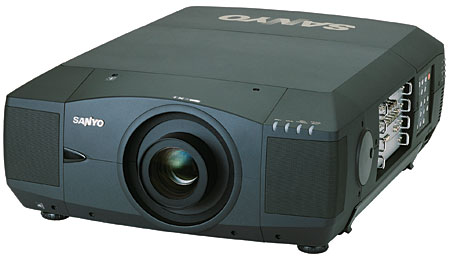
Sanyo PLC-XF47N Projector
The group's executive director, Lianne Caetano, gave me an idea what WiHD's specs will look like. The first-generation products will be capable of up to 4 Gbps (that means 1080p) at 32 feet. The 60-GHz band can allow a bandwidth of up to 7 GHz. That means that WiHD could theoretically achieve speeds up to 15 Gbps, which would more than accommodate any foreseeable hikes in HD resolution. Caetano says that WiHD offers true "baseband" uncompressed video, meaning that no bits are dropped in the transfer. This is an in-room solution employing smart-antenna technology to improve reliability and lessen the need for line of sight between transmitter and receiver.
WiHD is a bit behind the others in product development, and the 60-GHz band is uncharted territory. But the involvement of so many major CE manufacturers will certainly give the format legs when it launches. Caetano also indicated that several significant companies, including some from the PC realm, are now considering membership; those announcements are expected soon.
• www.wirelesshd.org
Choice can be a good thing. When discussing standalone products, these wireless-HD technologies offer an intriguing diversity to suit various uses and environments. However, things grow more complicated once manufacturers embed the technology into products, forcing consumers to choose. Can all of these formats peacefully coexist, or will there be yet another confusing format war in our future? Time will tell.

"Bandwidth" is one of those unfortunate polymorphous words used by many to refer to several, often completely different concepts. Bandwidth is the range of frequencies a device operates in. It usually refers to an analog signal and is listed in megahertz, as in, "A single channel has a bandwidth of 40 MHz."
Most often, when someone says "bandwidth," they really mean "data rate," which usually refers to a digital signal and is listed in gigabits or megabits per second, as in, "1080p needs 3 Gbps."
The easiest way to think about this is that "bandwidth" refers to the size of the pipe, while "data rate" refers to how much is flowing through it. To paraphrase from a section of this article: "The 1080p signal is transmitted at 3 Gbps [data rate] over a 40-MHz channel [bandwidth]." In the context of this article, the size of the pipe is less important than how much is going through it. You could have an analog bandwidth of, say, 500 MHz, but, if for some reason you can only send 50 Mbps of digital data over it, you're not likely to get uncompressed HD video out of the other end.
"Frequency range" refers to where in the overall electromagnetic spectrum the swath of frequencies that comprises the pipe is centered. This is also stated in megahertz or gigahertz, which can add to the confusion. To continue our example: "The 1080p signal is transmitted at 3 Gbps [data rate] over a 40-MHz channel [bandwidth] at 2.4 GHz [frequency range]."
- Log in or register to post comments


